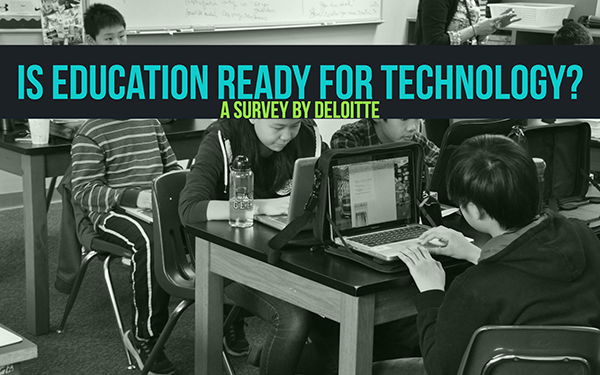Is education ready for technology? - A survey from Deloitte
 Lucie Renard —
Lucie Renard —
I remember my first computer. I could take a shower between pushing the button to start the computer and reaching a fully loaded desktop. And I’m not even that old!
We are in a time where technology evolves faster than the capability of the human being to learn it. Besides the fact that technology has an impact on education as the preparation for new jobs, it also has an impact on the way people learn.
Deloitte’s global Technology, Media & Telecommunications (TMT) practice has commissioned a survey, known as the “2016 Digital Education Survey”. Its goal is to better understand how digital transformation is impacting our education ecosystem, both inside and outside the classroom. The survey predicts some new trends in education.
So, what is meant by the “digital” of digital education? Digital refers to education technology such as devices and digital learning materials such as educational software apps, games, videos, audio, research sources, ebooks and virtual reality.
Today’s classroom
A typical school day is going to class from roughly 8 a.m. until 3 p.m. With technology knocking on the classroom door, that model is changing. The digital and technology-centric behaviors of students, teachers, and parents are expanding the way learning occurs. Learning can now take place outside the normal school day.
Technology makes new learning systems possible. Think about BYOD, adaptive learning, flipped classrooms and massive open online courses.
Today, almost half of the classrooms use a digital device every day. Laptops, desktops and tablet are the leading devices with more than 50%. On top of that, 75% of teachers believe that digital learning will completely replace printed textbooks within the next 10 years.
Now is definitely the time to start using technology if you haven’t gotten to it yet. Despite the high use of technology, 4 in 10 teachers say their school is not up to date when it comes to technology adoption and implementation.
You can also see some links between the age of the students and which learning devices are used. A tablet is used more for younger students. In grade K-2, 53% use tablets as a device. When you look at grade 9-12, that’s only 25%. Where tablets reach a younger audience, laptops do the opposite. Only 15% of the grade K-2 classes use laptops, where that is 37% in grade 9-12.
Using technology in your classroom can mean anything. So what do we mean by using digital learning materials? Which digital learning materials do you use in your classroom in a typical school week? Well, 67% of the teachers use online educational videos and 65% use educational apps or software. 56% of the teachers use websites for research and just over half of the teachers use games that are focused on specific content or skills. 17% use ebooks and 13% of the teachers are already implementing simulations and virtual reality. Way down the list, with 2%, are teachers who are using eMagazines.
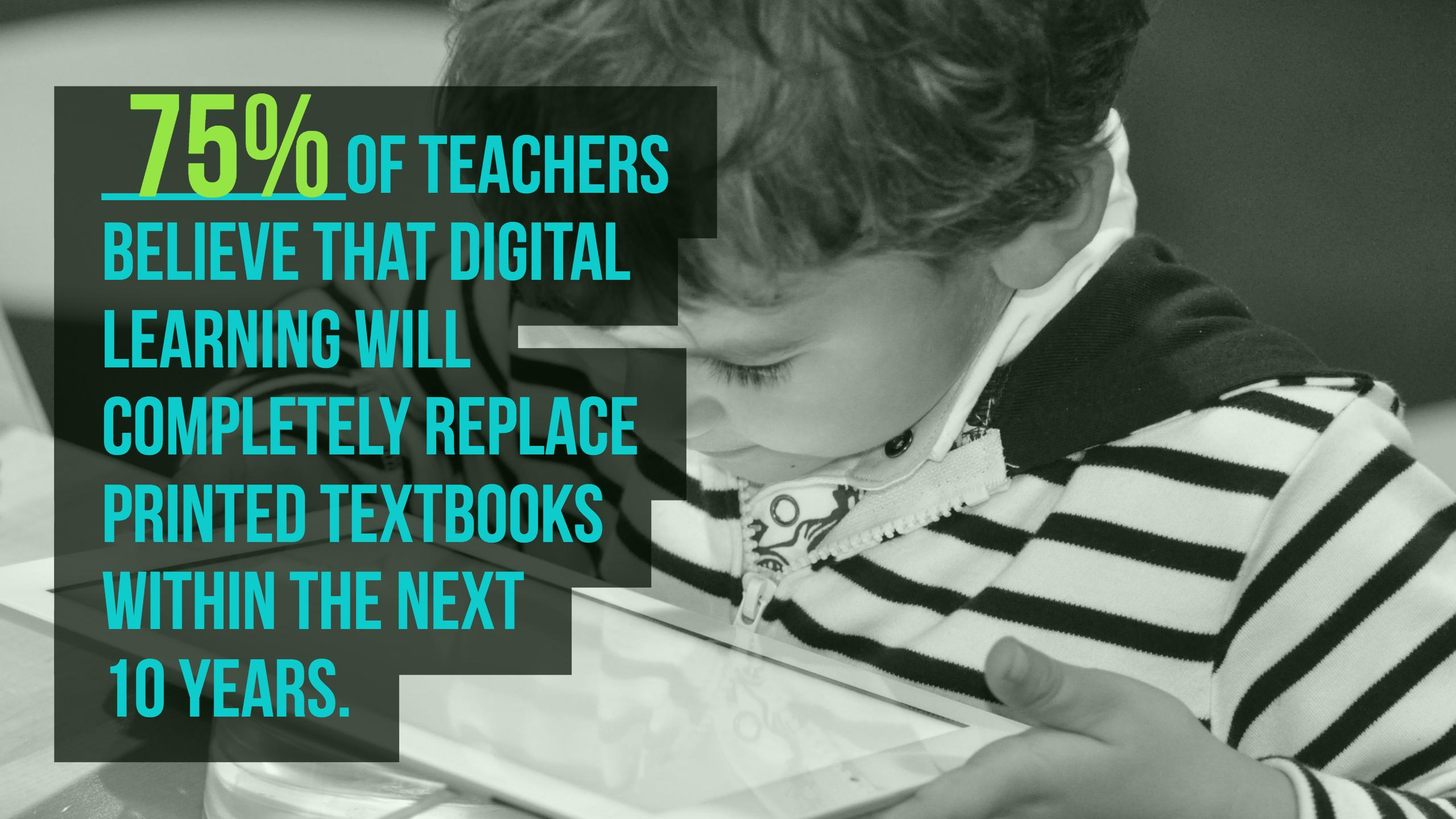
Expanding the classroom
The availability and adoption of devices at home, along with the growing interest by teachers, parents and students in continuing learning outside of the classroom has created an expansion of the education ecosystem. Education can now take place outside the classroom. Teachers see its potential, but also assume boundaries. There are still gaps between the beliefs of teachers that technology might be useful and their actual frequency of use.
TNT asked the teachers if they could indicate if technology made a positive difference in learning on specific topics. Here are a few statistics:
- 79% believe technology makes a really big difference in making learning more interesting. 57% use technology at least 3-4 days a week to accomplish it.
- 74% of the teachers believe technology provides opportunities to learn outside the classroom. Only 33% actually use technology to accomplish learning outside the classroom. Notice the difference?
- On the topic “allowing students to get feedback and help even when school is not in session” 64% of the teachers believed technology can make a big difference. Only 25% of those teachers really use technology to do so.
Despite the gap, parents and teachers plea for more school-related, at-home content. 88% of the parents and 84% of the teachers are interested in having more digital content available for students at home to supplement what’s being taught in school. If you think students think differently in the matter than parents and teachers, you are wrong. 75% of the students are interested in spending time learning more about the things they learn in school when they are not in school.
The majority of students are already learning digitally at home. To be more specific: 99% of students use digital learning materials at home and 2/3 of them start by the age of 5. At the age of 3, already 16% of the kids have started working with technology. That makes 57% of the kids between the age of 2 en 5 who have already started using digital learning materials or devices outside the school setting.
The accessibility of learning materials, made possible by technology, has a downside though. 73% of kids say more access would increase their time spent learning over the summer, even when they don’t have to go to school. Learning is great, but downtime and playing are necessary as well.
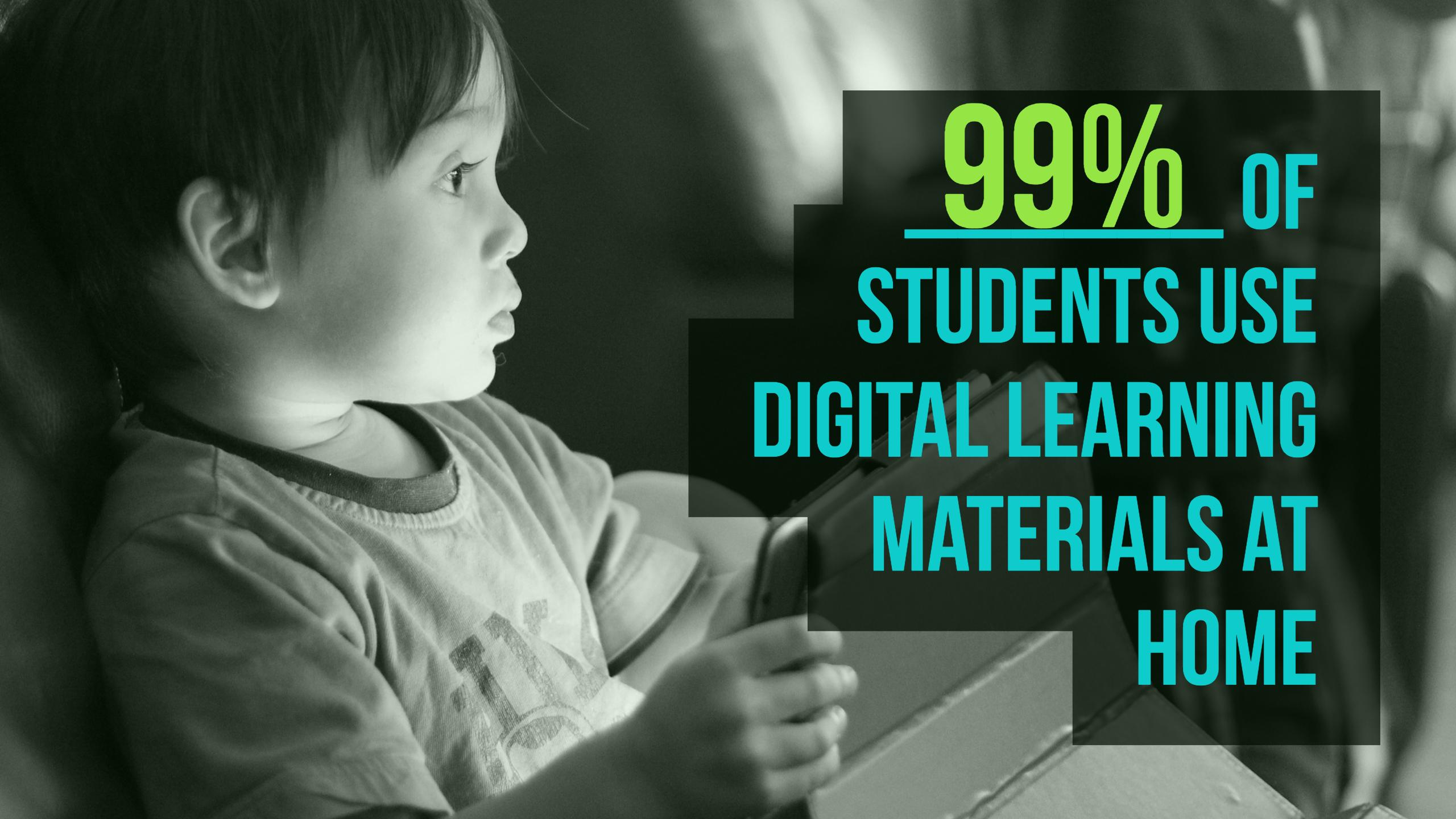
Expectations and motivations
The expectations and motivations driving education technology use are very varied between teachers, parents and students. Understanding the biggest motivations for digital learning material acquisition can be useful in setting up product design, learning objectives and marketing strategies.
When we take a look at the teacher’s motivation, we clearly see that teachers find student engagement the most important hook for using digital learning materials (74%). The second reason, with 61% of the teachers, is to have materials that are fun and entertaining for their students.
Parents are, on the other hand, more likely to use digital learning materials to develop the skills they want to improve in their child (53%). If it’s not improving skills, it must certainly engage their kids (45%).
Children have a wider variety of motivators when it comes to learning outside the classroom. On the question “Who or what makes you want to learn when not in school” the most popular answers were: “having the chance to learn new things” and “getting to do assignments that are fun”. Other motivations were: “wanting to do what my parents expect me to do”, “getting to use technology to learn”, “having the chance to learn with friends”, “getting good grades in school” and “wanting to be more prepared for what I will need to learn and do in college”.
91% of parents are comfortable with their children using devices independently to play digital learning games, although they are more likely to allow their child spend more time with educational videos (81%) or apps (80%) than with educational video games (68%).
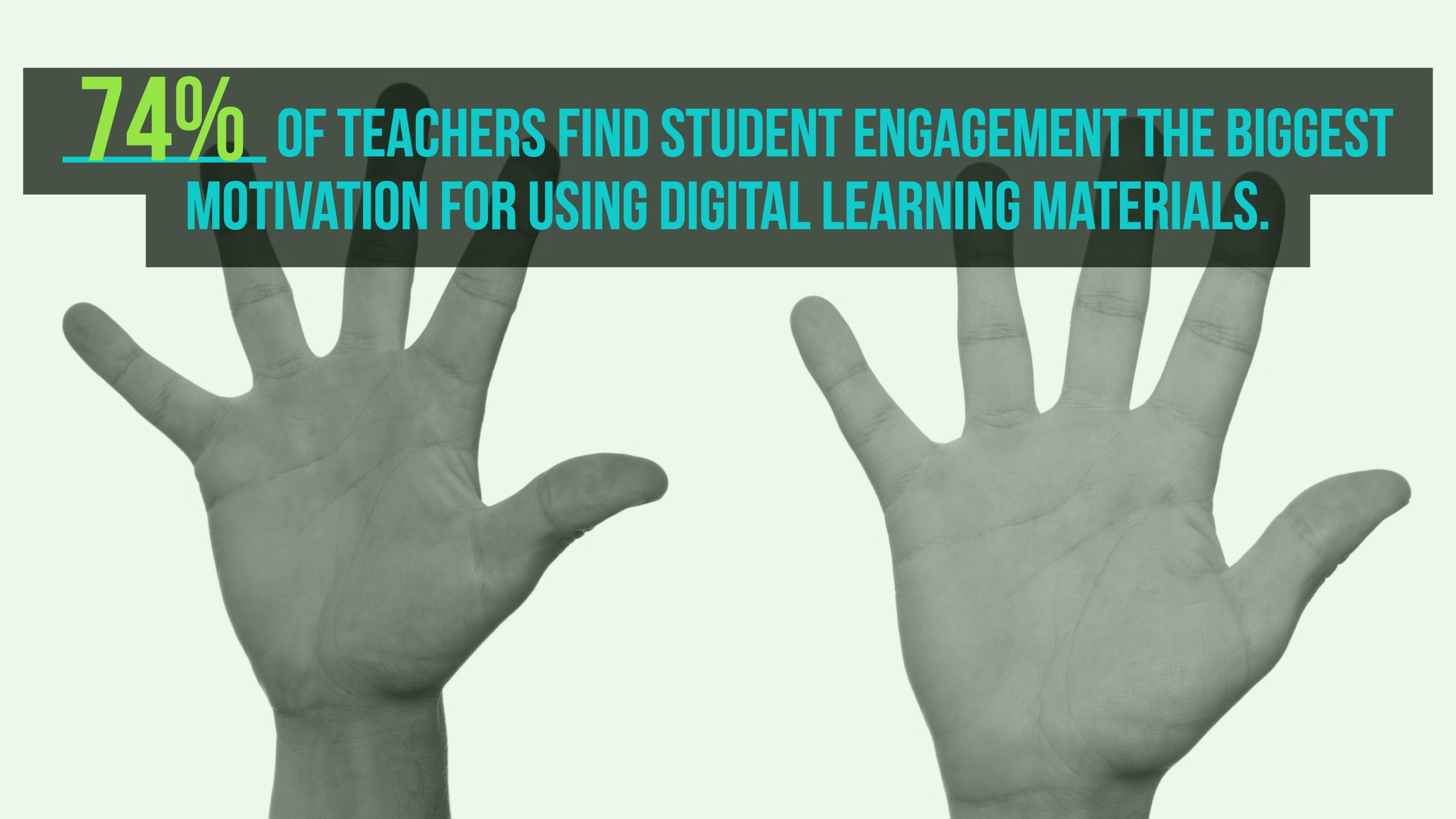
The influence of teachers
Deloitte’s survey shows that teachers are trusted by other teachers, parents, and students. They are looked to for advice and knowledge regarding education technology. Teachers are the influencers regarding technological adoption.
Teachers do favor digital learning materials, but there are also some barriers. 63% of the teachers say the school doesn’t have the funding and 60% says that there aren’t enough devices per student. In 45% of the cases, the wifi connections are too slow. Another 44% of the teachers state that the current school devices are too old. These are all financial barriers, chosen by 87% of all respondents.
61% of the respondents say there are also some classroom integration issues. 41% say that teachers aren’t trained in using educational technology and 31% states not to have enough time in the day to make greater use of educational technology. 22% claims to have difficulties to integrate digital learning materials with current instructional content. In some cases (7%), the school or district administrators don’t support using educational technology and 6% just don’t believe that educational technology enhances student learning.
The years of being a teacher also have an impact on whether they support educational technology or not. 81% of teachers with 10 or fewer years experience believe technology at school makes a big positive difference on students’s learning. When you look at teachers with 11-20 years on the counter, the percentages decline to 73% and for teachers with more than 20 years experience the number sticks around 64%.
Like the survey has shown, 81% of the kids said that they did some summer learning. 41% of the kids read books and ebooks, 32% played some educational games, 28% watched educational videos and another 28% used learning apps. These are the top activities. But why are kids learning during their summer break? Well, in most cases (up to 50%) it is because their school teacher suggested it. The second most common reason is just because they liked it. Finally, up to 20% of the kids studied because they were required to for school.
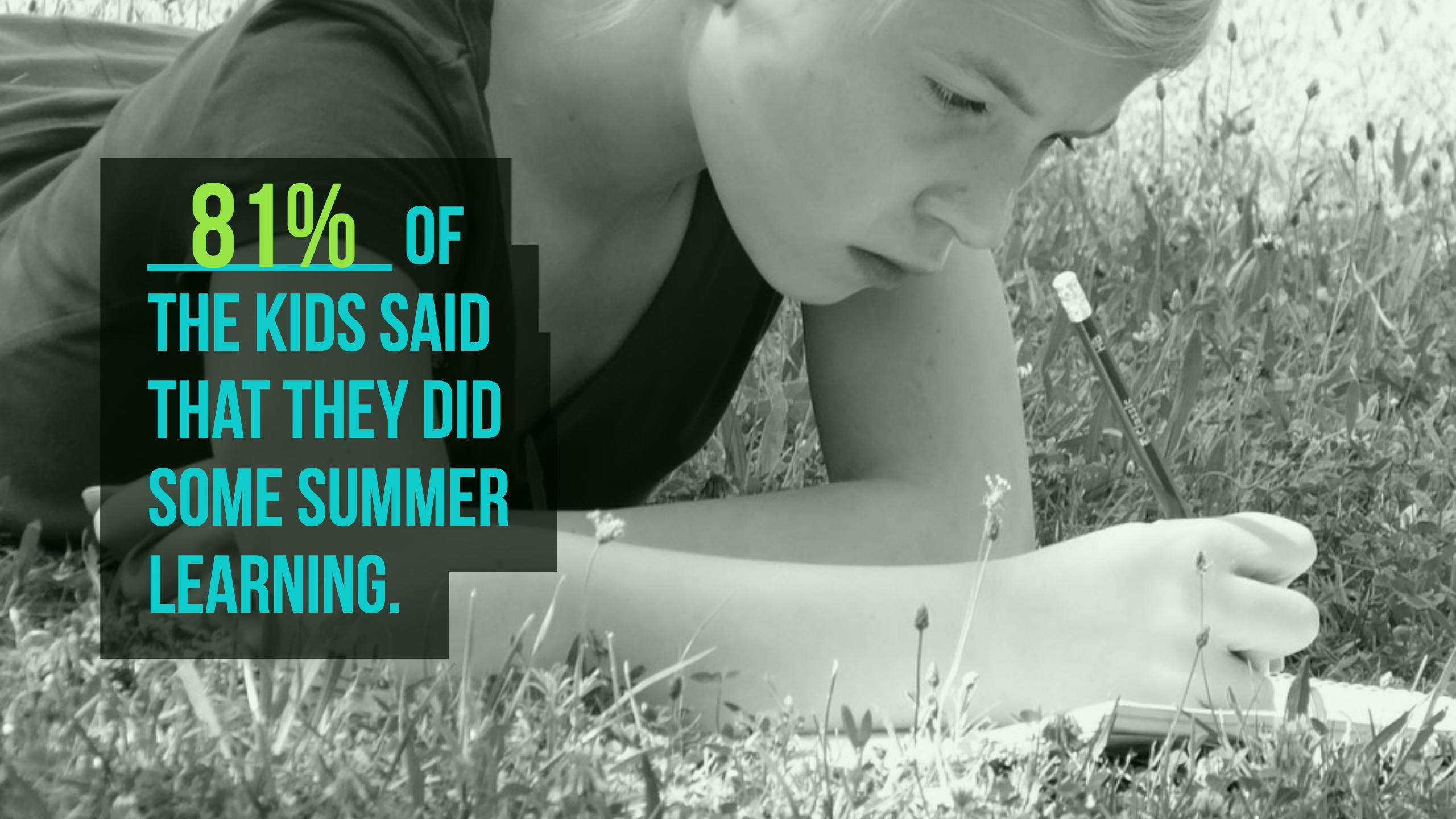
Who do teachers and parents trust when choosing the right device and digital education materials? The survey shows us that teachers also trust each other very much. On the question “Who do you trust for advice in the best type of devices for your students learning in school?”, 78% of the teachers answered “other teachers”. 43% also trust school or district administrators and 38% trust their students. We can state that teachers are suspicious of advertising and branding (10%) and the parents of their students (12%).
When it comes to the best type of digital education materials, statistics are almost equal to each other. Parents trust that teachers know the best types of devices and digital education materials.
When selecting digital learning materials, parents chose a brand that is recommended by their child’s teacher (46%). They choose also a brand that is valuable (45%) and that has the very best content (43%).
Infographic
The people at Deloitte put together this nice infographic to sum up their findings:

Learnings
We have learned that teachers, parents and students are ready for digital devices and learning materials. Despite the motivations that drive those parties to use technology, there is still a problem. There are some financial barriers and classroom integration issues. Maybe teachers can persuade the school administrators? We know, after all, that teachers are the greatest influencers when it comes to digital learning material.
When you or your school has to choose the right device, you can rely on your colleague teachers or you can choose yourself. Sometimes the type of device depends on your way of teaching. This post should make it easier to decide what device is best for you: iPads vs Chromebooks.
When your school doesn’t have the rersourses, you can propose a good solution to its administrators. Try to implement BYOD. Take a look at this post about BYOD: What is BYOD? Some pros and cons.
